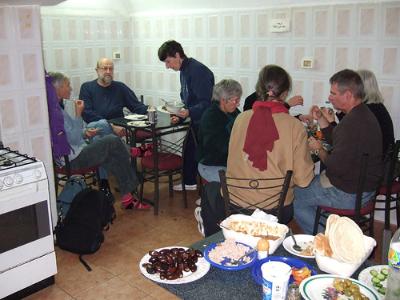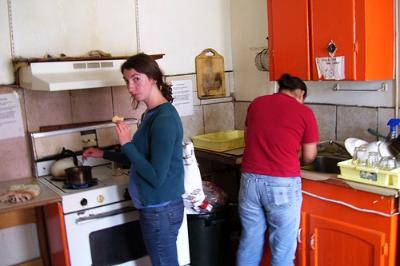How To Make a Hostel Dinner
by BootsnAll
 So, you have been on the road for a while, your wallet is feeling a little thin and eating out has lost all novelty factor. You check into a hostel and notice that it has a kitchen. Home-cooked food at last!
So, you have been on the road for a while, your wallet is feeling a little thin and eating out has lost all novelty factor. You check into a hostel and notice that it has a kitchen. Home-cooked food at last!
But you are no Jamie Oliver or Martha Stewart. Cooking for you usually involves a ready-made meal and a microwave, or a takeaway menu and a phone. Or maybe you can throw together an edible dinner, but you need your dusty old copy of The Joy of Cooking, and your mortar and pestle, and a local supermarket where the checkout girl understands your language. Or maybe you think good food equals expensive ingredients and lots of time.
However, at the risk of sounding like a cheesy cookbook author, you can throw together a hostel meal with minimal cost, time, and effort. So it’s time to do roll up your sleeves and do some cooking, backpacker style.
Step One: Determine what’s available in the kitchen
Not all kitchens are created equal. I once bought frozen pizza only to discover afterwards that the hostel kitchen had no oven. The chewy base you get from microwaving pizza is edible, but barely. Making guacamole with a blender is one of the easiest jobs in the world. Making guacamole without a blender is a messy and time-consuming task.
Many hostels have a “free box”, made up of food left behind by other hostellers and perhaps common items like salt and cooking oil. Check the contents of the free box and you can avoid buying items already there. But don’t forget to check best-before dates.
Step Two: Determine how many people you are cooking for
 If you are traveling with a companion, it’s a good idea to set out a rotation for cooking and, perhaps more importantly, cleaning up tasks.
If you are traveling with a companion, it’s a good idea to set out a rotation for cooking and, perhaps more importantly, cleaning up tasks.
If you’re staying more than a night, it may be possible to do a deal with other hostelers, for example sharing your dinner with them tonight and you can share theirs tomorrow night.
But cooking on your own can also be rewarding, and there’s nobody to complain if your culinary efforts don’t result in haute cuisine.
Step Three: Source your ingredients
Ingredients can make the difference between a terrible meal and a good meal, or between a good meal and a great meal. Local knowledge is invaluable. Hostel staff are generally used to guests asking directions to the nearest grocery shop, marketplace, or supermarket. If this fails, try asking someone in the street.
Before you go shopping, make a list. But be prepared to make substitutions if the shop doesn’t have what you want. If you can’t buy fresh herbs, maybe dried herbs will do. If there’s no mozzarella in the supermarket fridge, what about another type of cheese? Maybe this recipe would be just as good with rice as with noodles. A little imagination goes a long way.
Availability obviously depends on location, and you can often find the best value by sticking to local specialties. Personally, I love markets for the atmosphere and the interaction. I never feel more like a real traveler than when I’m wandering around a marketplace.
You know that phrase book you thought you’d never use? Well, here’s your chance to use it. It’s a good idea to learn the following phrases in the local language:
- Numbers from one to ten
- A slice of…
- A (half/quarter) kilo of…
- Sorry, I don’t understand
- How much?
- What do you recommend?
- Please
- Thank you
But if all else fails, you can go a long way by pointing at what you want.
Buy in the smallest quantity necessary. Bulk is only cheaper if you use it all. Of course, you can always leave leftovers in the “free box” for travelers who come after you.
While you’re shopping, don’t forget to buy something to drink with your meal!
Step Four: Bring your ingredients to home base
Many hostels request that you label all food with your name and departure date, but it’s good practice to do this anyway.
Step Five: Now cook your dinner!
 Set out the ingredients and equipment (pans, chopping boards, etc.) and it’s time to start cooking.
Set out the ingredients and equipment (pans, chopping boards, etc.) and it’s time to start cooking.
What you cook depends on your own tastes and resources, but here are a few quick, easy, cheap meals to get you started. (v) indicates that the meal is suitable for vegetarians (although not necessarily vegans). All meals serve two, so scale up or down as necessary.
Omelette (v)
Ingredients: 6 eggs, 1 medium sized onion
- Chop the onion and fry over a medium heat.
- Add more oil, then beat the eggs and add to the pan.
- Fry on medium heat until the bottom of the omelette is solid.
- Slide the pan under a heated grill to heat the top of the omelette. (You can also flip the omelette and fry the other side, but the grilling method is more foolproof.)
- Tip out onto a plate and serve with crusty bread.
Note: You can add tomatoes, tuna, cheese, or bacon to the omelette; simply mix in with the egg. If you want to add potato (Spanish-style), chop the potato into small cubes and add at the same time as the onion, frying at a low heat until soft.
Spaghetti Bolognese
Ingredients: 170g/6oz spaghetti (or other pasta), 250g/8oz minced beef (preferably round steak), 1 medium sized onion, 1 carrot, 1 tin chopped tomatoes (or two cups fresh tomatoes, chopped), teaspoon dried herbs (mixed herbs, oregano, or basil), half cup red wine (optional)
- Brown the mince in a frying pan. Line a plate with kitchen towel and leave the mince on the plate to the side.
- Fry the onion and carrot on a medium heat until soft.
- Add the tomatoes, wine (optional), herbs, and mince.
- Bring to the boil, then simmer for 15 minutes.
- While the other ingredients are simmering, boil the spaghetti until al dente (with a slight “bite”). With dried pasta, this normally takes 8 to 10 minutes; with fresh pasta, 4 to 5 minutes.
- Drain the spaghetti and serve with the Bolognese sauce.
Note: You can make this recipe vegetarian by substituting quorn for beef.
Pasta with Feta Cheese (v)
Ingredients: 170g/6oz pasta, 85g/3oz feta cheese, 16 cherry tomatoes, handful fresh basil (or teaspoon dried oregano), 3 tablespoons whole olives, half cup olive oil (preferably extra virgin)
- Boil the pasta until al dente (with a slight “bite”). With dried pasta, this normally takes 8 to 10 minutes; with fresh pasta, 4 to 5 minutes.
- Drain the pasta and add the feta cheese, tomatoes, basil or oregano, olives, and olive oil.
- Mix well and serve.
Note: Cherry tomatoes are best, but you can use larger tomatoes if you slice them. You can also add tinned tuna or pine nuts.
Almond Chicken
Ingredients: 2 breasts chicken (or 4 chicken thighs), 2 medium sized onions, 2 handfuls green beans, 2 tablespoons soy sauce, 1 tablespoon honey, handful whole or sliced almonds
- Slice the chicken and brown in a frying pan. Line a plate with kitchen towel and leave the chicken on the plate to the side.
- Fry the onions on a medium heat until soft.
- Add the green beans, chicken, soy sauce, and a drizzle of honey.
- Bring to the boil, then simmer for 15 minutes.
- Add the almonds and simmer for 5 minutes.
- Serve with crusty bread, pasta, or rice.
Note You can substitute red or green peppers, sliced courgette (zucchini), or carrot for the green beans.
Step Six: Clean up
I really shouldn’t have to tell you this, but, unless you brought your servants with you on your trip, it’s up to you to scrub those pots and leave those plates as you found them.
original photos, top to bottom, by: heatheronhertravels, delayed gratification, sprocket003